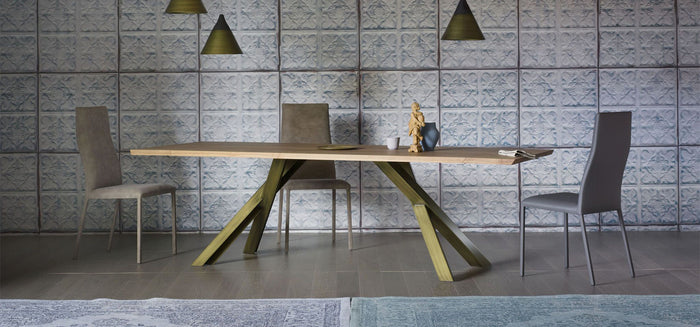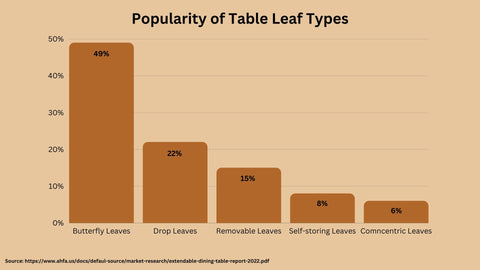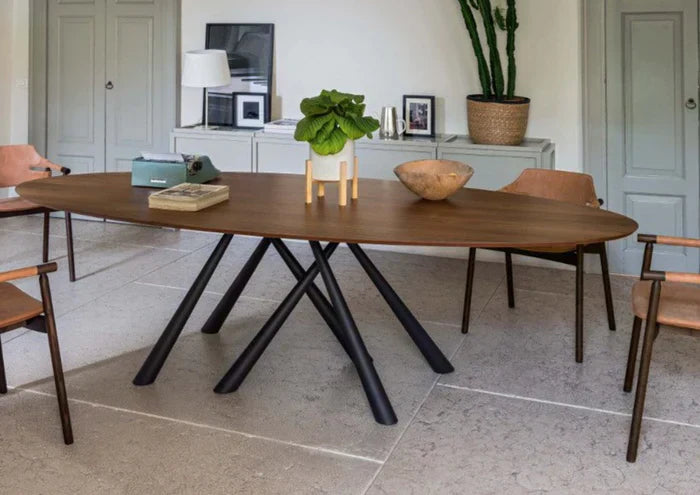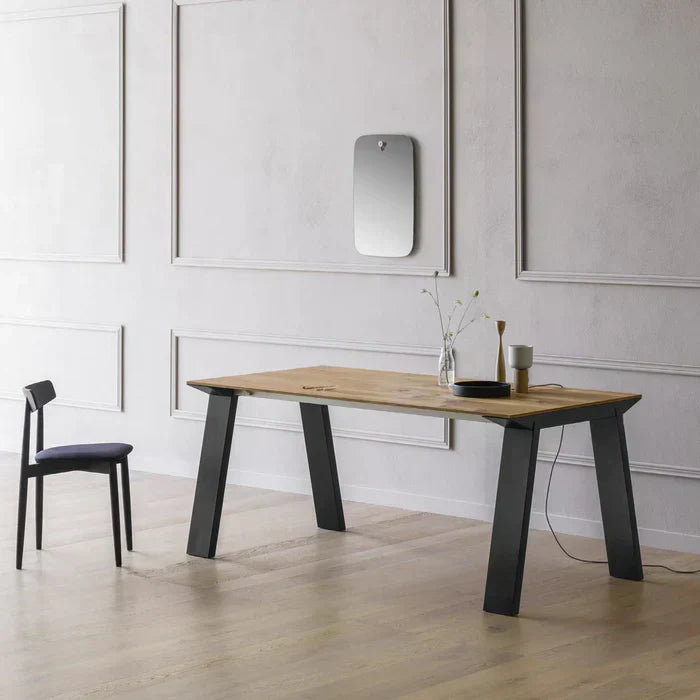
Dining Table Leaf: What You Need to Know about This Feature
A dining table leaf can be an invaluable addition to your dining space. Its best feature is its ability to expand and contract per your needs. You can accommodate small intimate gatherings and large festive occasions with leaves.
For those unfamiliar, a leaf is a part of a dining table that can increase its surface area. It allows you to extend your dining table if you wish to accommodate more people.
With so many options out there, how do you choose the right dining table leaf? This guide will walk you through everything you need to know. We’ll discuss dining table leaf types, sizes, and cost.
The Importance of Choosing the Right Table Leaf

Why is choosing the correct table leaf so important? The leaf you select can make or break your dining experience. An ill-fitting leaf can wobble when expanded, or it could fail to integrate into your table’s design.
But, the right leaf can expand your usable table space when you need it. It could also fit discreetly in the dining table space when you don’t need it. Be sure to consider your space and needs before selecting a leaf.
Measure the dimensions of your room and existing table. Think about how much extra space you need. Will you use the leaf often or only on special occasions? Keeping your specific situation in mind helps to narrow down your options.
Types of Table Leaves: Beyond the Basics

While most leaves fall into a few categories, some variations offer certain considerations:
Butterfly Leaves
Butterfly leaf dining tables are ideal for those lacking extra storage space. Butterfly leaves fold in half width-wise for compact storage. A survey in 2022 showed that nearly half of all homeowners buying leaf tables preferred butterfly leaves.
How They Work
Butterfly leaves allow square tables to expand into rectangles, and round tables into ovals. The two leaf halves lift and rotate outward from the center of the table to a locked position.
Drop Leaves
Drop leaf dining tables are perfect for small spaces. Drop leaves offer excellent flexibility. They allow you the option to use just one leaf to extend the table into a semi-circular shape.
How They Work
One or two drop leaves are lowered into slots at each end, or along the sides of the table. When needed, they can be raised into place.
Removable Leaves
Removable leaf dining tables are ideal for maximizing usable table space. Removable leaves offer the greatest expanded surface area.
How They Work
These tables have leaves that can be removed and stored in rails under the table. You can then close the table top to hide these leaves away from view. So, they need dedicated storage space when not in use. Installation involves physical effort to insert leaves into the table.
Self-Storing Leaves
Self-storing leaf dining tables are ideal for streamlined storage and easy use.
How They Work
Self-storing leaves are commonly found in butterfly and removable leaf tables. The leaves in these tables slide discreetly inside the table frame. Or, they are stored upright with the use of nearby racks. This enables a smooth, no fuss extension by a single person.
Concentric Leaves
Concentric leaf dining tables are ideal for maintaining a round table’s shape when expanded. Concentric leaves are curved to fit snugly around a table’s circumference.
How They Work
The concentric design offers both aesthetic appeal and functionality. It does this by providing a smooth, continued edge and legroom in the expanded position.
The Mechanics: How They Work
Behind every functional dining table leaf is an intricate mechanical system. Removable leaves use tracks, channels, and rails engineered into the table frame. These help guide them snuggly into place. They also use locking brackets, pins or latches to secure them.
Self-storing systems rely on custom designed hinges, slides, and hardware. These features enable the leaf to pivot, lift, or slide into a storage position. When evaluating options, consider the ease of use. Well-designed hardware should allow one person to expand their table smoothly without any trouble.
Also, the leaf should remain sturdy when in use. Poorly made systems may bind, stick, or slip, so remember to inspect the mechanics of the leaf carefully before you buy a leaf dining table.
Material Matters: What Your Table Leaf Should Be Made Of
Table leaves come in a range of materials, each with their own aesthetic and functional implications:
Wood: A warm, classic choice available in numerous stains and finishes. Durable options like oak and mahogany hold up well over time. Also, wooden tables are easier to repair than those made with other materials.
But, remember that wood can expand or contract based on humidity and heat. This could affect the lifespan of your wooden dining table. In a survey conducted in 2022, over 70% of responders said that wooden drop leaf tables were the hardest to maintain.
Glass: These leaf dining tables are sleek and contemporary. The durable tempered glass leaves are transparent, seamless additions. Also, it’s great that you can choose the kind of glass you want for your table. The most popular options are tinted, clear, and frosted glass.
You can choose to get tinted or frosted glass, as well, if you use your dining table very often, or have children. Clear glass dining tables tend to show fingerprints very easily. This could make it quite difficult to clean them.
Faux Marble: This material offers the visual appeal of natural stone with less weight. Resin-based marble leaves are affordable and mimic the look of the real thing.
Plastic: These leaf tables are lightweight and affordable but less durable. Plastic leaves may warp, crack, or discolor.
When selecting a material, consider your lifestyle. For example, lightweight plastic may suit those who remove their leaf frequently, but long-lasting wood or marble work better for full-time use.
The Aesthetics: Matching Your Table Leaf to Your Dining Table
A cohesive aesthetic between your existing dining table and leaf is key. When expanded, the transition between the two components should be subtle and complementary. Consider color, texture, and design elements carefully. If your table has distinctive woodgrain, a leaf with similar detailing should blend seamlessly.
Match the finish of an ornate table with carved accents with a leaf in a complementary style. A stark difference in color or pattern between table and leaf can look disjointed. The safest bet is matching your manufacturer’s recommended leaf design, or you could choose a simple, neutral hue and finish that fits in rather than stands out.
FAQs: What You've Been Asking
Q1. How Do I Store My Removable Leaves Safely?
Improper storage can damage leaves over time. Avoid moisture, direct heat, and laying leaves on concrete floors. Store them horizontally on a level surface even when they’re not in use. Try to use felt pads when stacking leaves to prevent surface scratches. Keep in mind that very dry conditions may cause warping of the leaves, and humidity can foster mold.
Q2. Can I Customize the Size of My Table Leaf?
Sure! Many manufacturers can customize the shape and dimensions of your leaf for a tailored fit. This is especially useful for tables lacking a standard shape or size. Be prepared to pay a premium for custom work, though, and have your existing table measurements on hand.
Q3. How Many Leaves Can I Add to My Table?
Most tables can accommodate 1-2 leaves comfortably, but some can handle more. Consider your table’s designed expansion capacity, leg stability, and the tone you want to set. A table packed with numerous leaves may feel unstable. Your safest bet is sticking to the number of leaves designed for your specific model.
Final Thoughts: Making the Right Choice
The dining table leaf you choose can enhance your dining experience for years to come. On the other hand, it could also hinder it, if it's poorly matched to your needs. Keeping your lifestyle, design aesthetic, and budget in mind while shopping can lead you to the perfect customized fit. With some care and foresight, your leaf can blend beautifully into your existing space.
So, take your time, review the options, and consider the tips we’ve outlined above. With some careful evaluation, you're sure to find the ideal leaf to transform your dining experience.
Written by Noah Redwood
Noah Redwood is a seasoned lifestyle blogger and content creator with a passion for luxury furniture and home decor. With years of experience working with prestigious brands and a keen eye for design, Noah brings a unique blend of storytelling and expertise to every post.



